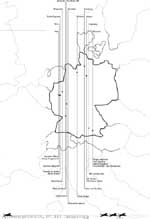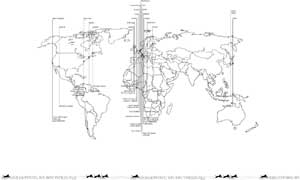|
|

|
||||||||||
|
|
|||||||||||
|
|
CAT - Communication, Art, Technology : History of a project - step by step The CAT feasibility study is the program for developing the Internet platform netzspannung.org. It was the starting point for the media lab in the internet which is under development at MARS-Exploratory Media Lab. |
||||||||||
|
|
|||||||||||
|
|
|
|
|||||||||
|
|
|
||||||||||
|
|
|||||||||||
|
The task [»CAT history begins in August 1998 after a lengthy planning stage. The Bundesministerium für Wissenschaft und Forschung (bmb+f) (Federal Ministry for Science and Research) is commissioning MARS-Exploratory Media Lab to do a feasibility study on a »competence centre for art, culture and new media«. Our title, CAT - Communication of Art & Technology, is to emphasise the direction the studies are to take. There is a need for a digital media centre for the communication of art and technology.« Monika Fleischmann, Wolfgang Strauss] In 1998 the Bundesministerium für Bildung und Forschung (Federal Ministry for Education and Research) commissioned Monika Fleischmann, Head of MARS-Exploratory Media Lab at the GMD - Institute for Media Communication to carry out a feasibility study for a competence centre for art, culture and new media. At that time the interdisciplinary field of art, culture and technology had not yet been opened up in Germany. The CAT feasibility study placed less emphasis on the display and development of software in the cultural context and more on the question of how experiences of artists, scientists and designers with information technology systems can be made sensory and meaningful for todays society. This involves culture technology, an area of basic research in the field of digitized communication. New tools and methods must be drawn up, mechanisms and structures for media production created and tested and their applications specified for the public. The role of media art Meanwhile various artistic fields have been established within media art which investigate and represent the interaction between people and machines or communication between people. Digital art can be displayed in the form of electronic film, autonomous objects, dynamic sculptures, interactive installations, with or without an Internet connection or only on the Internet. Today, they can be produced in part with very simple hardware and software components which are easy to operate. Complex concepts can only be implemented when artists have the opportunity, as is customary with computer scientists, to conduct research over longer periods of time in an interdisciplinary environment which offers them good technical support and professional production opportunities. The implementation of digital environments and interactive communication spaces through the use of media art makes culture and technology socially accessible and creates a new dynamic reality. Feasibility study The 1998 study carried out by the MARS Lab team lead by Monika Fleischmann and Wolfgang Strauss formulated a vision of a competence centre for culture, art and new media which has not yet been created in this form at a European level. This competence centre is to bring together art and design disciplines [1] working with new media - such as audio-visual art, architecture, design, theatre and music - with education, research and business. The CAT project (Communication of Art and Technology) was defined as an interface which is useful both to users and developers of new information technologies (computers, satellites, networks, sensors etc.) and to artists, designers, cultural institutions and businesses. CAT is to become a network for the communication of art, culture and new media. The network is a communication, service and work platform which, through documentation, observation and networking, will determine and play a part in shaping (through its own key areas of research) the status quo of the available capacities and expertise. A lively exchange of information should give a boost to innovative cooperations and produce synergy effects between art, culture and new media business. In 1998 the key task of the CAT project was to analyse existing developments and opportunities for media art applications in Germany. It involved developing key areas to promote, furthering collaboration with cultural institutions and trying out various models [2].
CAT focused on three types of expertise: The relationship between art, culture and technology in Germany
The development of digital technologies brings new demands for media art. It is gradually developing its dynamic potential by bringing together various disciplines from the fields of information technology, media culture and design at the interface of its developments. CAT's key areas of content research in 1998 included interactive television, the virtual studio, virtual reality and environments, intuitive interfaces, tele-presence, interactive scenarios, film and narration, mixed reality for the stage and theatre and new concepts in media-cultural practice for training (CD-ROMs) and entertainment (theme parks). In general this profile represents the belief that, alongside the development of the media infrastructure (information architectures) in all areas, be they art, education, entertainment or public relations, appropriate contents must be developed which adhere to the didactic of interactivity [3]. E-mail action in late summer
[»To reassure ourselves that a digital media centre for the communication of art and technology was really needed, we sent 150 letters in an e-mail campaign to the digital media community in late summer requesting the answers to 10 questions: 1-10 Although it was during the summer holidays we received around 75 replies within 4 weeks. The most interesting comments from this international arts jury are documented on
The
»Aesthetics no longer allies itself with art but rather with communication. And even if it can no longer be regarded as a historic theory of art, aesthetics can become a pioneering science - the theory of media communication awareness.« (quote : Norbert Bolz, on
The practical application of this theory had to be supported using a network. Rather than improving on available technologies, a technology for the networked society was to be developed using media communicated awareness as a leitmotiv. International reactions [»International reactions are meeting with our expectations. What is urgently needed is a media laboratory on the Internet. In two further surveys of experts including well-known representatives from the worlds of art, culture, politics and business, this concept is seen as both desirable and achievable. The setup of the media laboratory on the Internet is to be commissioned in October 99 . The (bmb +f) is supporting the development of netzspannung.org for three years«] In mid September 1999 the results of the CAT feasibility study were once again put before a circle of experts gathered especially for this purpose. The end protocol formed the decisive framework for formulating the system architecture, resolving key editorial and contents-related points and shaping the information design on the web. Here are some of the experts' comments:
Axel Wirths, MEDIA GmbH, Cologne
Sha Xin Wei, Stanford University, USA
Harald Schütz, Kunstkommission der Deutschen Welle, and Monitor Department at Deutsche Welle, Cologne Right from the start, the CAT project has focused on two key points in parallel: firstly, the development of content fields and the involvement of relevant experts, and secondly, the development of the technical platform and its implementation within three years. Organisation and rights structure of the platform. [»This commission is receiving financing for 4 regular jobs and is to create around 15 time based jobs at MARS-Exploratory Media Lab and the Partner Lab for Distributed Systems at Siegen University. End of 2000, the core team consists of: Monika Fleischmann, Wolfgang Strauss, Jasminko Novak, Gabriele Blome, Boris Müller, Stefan Paal, Claudia Valle, Felix Schmitz-Justen, Predrag Peranoviv, Andrea Helbach, Heiko Hansen and Ulrike Boecking. Eight to ten senior students are implementing the concepts of the Netzspannung team to set up the netzspannung platform.«] The first question was the software technology to be used. Preference was given to a modular design (open source), as an open source platform gives opportunities for other uses. The platform is conceived as a toolbox which the user can access in order to change, shape or adapt it, both at programming and user level. The modular setup enables CAT to be designed on a socio-ethical level as a distributed community. In addition to an information-based functionality, it offers a multi-user communication level which in turn generates and promotes new exchange opportunities. The various configuration levels of the CAT network require a suitable and flexible organisational and legal form. But which legal form - as an organisational structure - meets the needs of a competence centre with different open and closed levels of action and communication that can be transformed into a functioning Internet media lab? Another comment on this subject:
Dr. Ludger Hünnekens, Kulturkreis der Deutschen Wirtschaft, BDI, Cologne (1999) - Allianz AG Kulturstiftung, Munich (2000)
Summary Taking the 1998 vision as a basis, five determining features which form a pivotal point for other interfaces of different communication concepts and levels are singled out for structuring the CAT platform. These are information, communication, cooperation, production and presentation. Through the gradual creation of an information platform (i.e. a distributed database system with different communication and presentation levels), the development of a mobile unit which transfers real and virtual communication flows, and a toolbox with different modules, the CAT platform concept grows into a communication and cooperation/production platform - netzspannung.org - in the year 2001.
[1]
[2]
[3] |
|||||||||||










 Intro
Intro